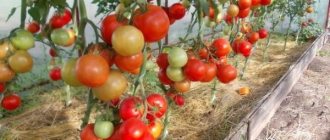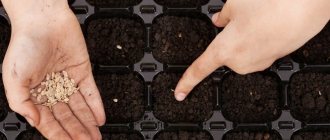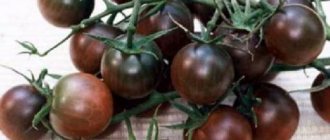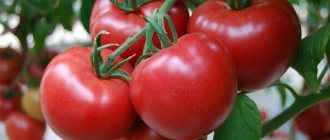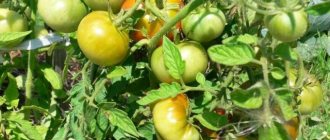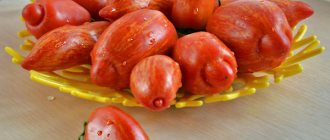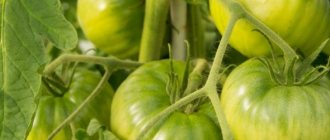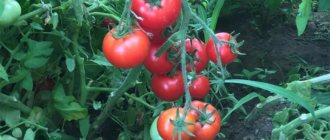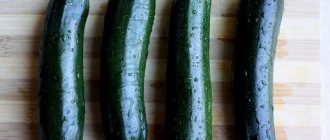Description of Tarpan tomatoes
Tomato Tarpan F1 belongs to the medium-growing varieties of determinate type. The bush is compact, the height rarely exceeds 70 cm, which makes it possible to successfully grow this hybrid in low greenhouses and significantly save space in the beds.
The green mass of this variety develops moderately. The leaf blades are medium in size and simple in shape, painted in a rich emerald color. The inner surface of the leaf is covered with small short fibers. The stems are powerful and not prone to pinching, which makes tomato care very easy.
The inflorescences of Tarpan F1 tomatoes are simple, 4-6 fruits are formed on each cluster. Large specimens ripen better and faster in greenhouse conditions. On average, 97-104 days pass from the first shoots to harvest.
Description of fruits
Tarpan F1 tomatoes have a flattened shape, the stalk has slight ribbing. The fruit is divided into 6-7 segments, the number of seeds is small. The peel is dense, which contributes to good preservation and transportation.
The fruits of the Tarpan F1 variety have a pleasant sweetish taste. The pulp is fleshy, medium elastic and very juicy. Its characteristic sugary structure is visible at the fracture. The color of a ripe Tarpan tomato is pink-coral, with a pronounced pearlescent sheen. Fruits picked from the bush at the time of biological ripeness ripen well in the warmth at room temperature, without losing their presentation and taste.
Tarpan tomatoes are medium in size. Weight, depending on growing conditions, ranges from 85-200 g, usually 150-160 g.
Advantages and disadvantages of a hybrid
Tarpan F1 has many advantages:
- exquisite taste of pink tomato;
- early ripening;
- use for baby food;
- attractive presentation;
- ability for long-term storage;
- good transportability;
- high resistance to many diseases;
- ease of plant care;
- saving planting space due to compacted plantings.
The serious disadvantages of the hybrid include the inability to propagate it with your own seeds.
Characteristics of tomato
Tarpan variety tomatoes are intended for cultivation both in greenhouses and in open ground (for regions with warm climatic conditions). This hybrid has all the properties inherent in most popular varieties of tomatoes. Cultivating tomatoes of the Tarpan F1 variety will not cause much trouble and is guaranteed to bring a high yield if you follow the basic rules of agricultural technology.
Productivity and fruiting
Tomato Tarpan F1 is an early-ripening, high-yielding hybrid. You won’t have to wait long for the first harvest: from sowing to ripe fruit – just over 3 months. From 1 m² per season you can harvest up to 12 kg of tomatoes of excellent quality and taste. In greenhouse conditions, the ripening of large fruits occurs faster and more efficiently, and therefore the yield in the greenhouse will be higher.
Natural thickening of the bush does not affect the productivity of this crop, however, removing excess green mass stimulates the plant to lay new ovaries and ripen already formed fruits.
You can increase the yield from one bush if you remove the fruits that have not yet turned red. This will allow the plant to direct its forces to new ovaries. To get maximum and fastest results, you need to follow a few simple rules:
- Tomatoes are removed from the bush early in the morning so that they do not have time to warm up.
- The fruits are cut with scissors, leaving the stalk.
- Optimal ripening conditions are temperature 13-15°C, air humidity - about 80%.
- To ripen, tomatoes are placed in boxes in 2-3 layers, lined with paper or sprinkled with sawdust to prevent the formation of condensation.
- If you have a small number of tomatoes, you can put them on a sunny windowsill.
- To speed up the ripening process, add several red and ripe ones to the green fruits; some gardeners use bananas or apples for this purpose.
Warning! Tomatoes ripened at high temperatures lose their taste.
Area of application of fruits
Tomatoes of the Tarpan F1 variety are used fresh for preparing salads and other cold appetizers. The relatively small size of the fruit allows them to be pickled whole, and the dense but thin skin prevents cracking. Tarpan tomatoes also make an excellent thick puree, suitable for baby food, and very tasty juice. The dry matter content reaches 6%, the maximum amount of sugar is 3%.
Resistance to diseases and pests
Tarpan F1 variety is resistant to diseases such as
- tobacco mosaic;
- fusarium;
- verticillium.
Proper agricultural technology often prevents pests from damaging tomatoes. If any are found, the above-ground part of the plant should be treated with an insecticide.
Advantages and disadvantages of the variety
The Tarpan variety is a welcome guest in any garden plot. Among its undeniable advantages are the following:
- excellent delicious taste both raw and cooked;
- marketable, presentable appearance of ripened fruits (up to 97%);
- the possibility of ripening unripe tomatoes at home;
- high productivity even in the leanest year;
- obtaining a harvest in a short time;
- excellent safety and possibility of transportation;
- Possibility of use as baby food;
- the compactness of the bushes, which allows you to save space when planting;
- resistance to major diseases.
Since the Tarpan tomato variety is a hybrid, the collected seeds are not suitable for use as seed in subsequent seasons. The seedlings will sprout, but will not transfer the qualities of the mother plant. This is the only drawback of the Tarpan variety, like all other hybrids.
Care
Pink tomato Tarpan f1 is unpretentious in care. It is grown both in open ground and in greenhouses.
Sowing seeds
Seedling boxes are filled with nutritious substrate for indoor plants or specialized for seedlings. Drainage must be laid at the bottom. Seeds are sown to a depth of 1-2 cm and watered abundantly. The box is covered with cling film and put in a dark, warm place until the first shoots appear. If necessary, the earthen ball is moistened from time to time using a spray bottle. Afterwards the box is placed on the windowsill on the sunny side.
Seedling care
Proper plant care will ensure a good harvest.
The future harvest of tomatoes depends on the quality of the seedlings. To grow strong and healthy plants, seedlings need to be watered, illuminated, loosened and fertilized in a timely manner.
Watering
From the moment the seeds are planted until the young shoots sprout into a separate container, tomato seedlings are watered once a week. The amount of water directly depends on the conditions in which the sprouts are located. The norm assumes slightly moist soil. Water stagnation should not be allowed, otherwise the roots of the seedlings will begin to rot. Strong sprouts are sprayed once a week. The optimal water temperature is 12-15°C.
Loosening
In order for the seedlings to develop well, the soil is systematically loosened. A day after the watering procedure, the soil is carefully fluffed up at the roots, taking care not to injure the plant; young stems are very sensitive to mechanical stress.
Backlight
If there is a lack of sunlight, it is recommended to illuminate young tomatoes with UV lamps. If the air is too dry, the seedlings will need to be sprayed with a spray bottle.
Growing rules
Tomatoes of the Tarpan F1 variety have no special requirements for cultivation; they are identical to the care of other tomatoes. It is enough to follow the rules and timing of sowing and replanting, do not forget to water, feed, weed and loosen the soil, and carry out preventive treatments against pests.
Planting seedlings
Seeds of the early ripening hybrid Tarpan F1 should be sown in early March. They do not require special disinfection treatment; all necessary manipulations have already been carried out at the manufacturer. To be on the safe side, you can briefly place the planting material in a warm pinkish solution of potassium permanganate.
You can prepare the soil for planting tomatoes yourself by mixing the following components in equal parts:
- turf and garden soil;
- peat;
- river sand.
Sprinkle the resulting soil mixture with a fertilizer solution per 10 liters of water:
- potassium sulfate – 25-30 g;
- superphosphate – 30 g;
- urea – 10 g.
You can also use purchased soil, but in any case, the soil for tomatoes must be disinfected before planting:
- bake in the oven or microwave;
- freeze;
- steam;
- spill with a solution of fungicides and insecticides.
Warning! When preparing a soil mixture for tomatoes, you cannot use manure.
Wide and low containers or boxes are suitable for sowing tomatoes. The seeds are placed in shallow grooves, lightly sprinkled with soil, moistened the surface with a spray bottle and covered with film or glass.
When the first shoots appear, the containers are placed in a well-lit, warm place. Picking into individual pots is done when the young plants have formed the first pair of true leaves. At the same moment, the first feeding of tomatoes is carried out. In case of subsequent transplantation into open ground, the seedlings must be hardened off by taking the containers to fresh air.
Tomato transplant
At the end of May, when the danger of spring frosts has passed, the seedlings are assigned to a permanent place in the garden bed. In the case of Tarpan tomatoes, it is enough to adhere to a 40*40 cm pattern between neighboring plants, optimally 4-5 bushes per 1 m². The transfer of tomato seedlings to heated greenhouses occurs a little earlier. Tomato seedlings, planted in peat pots, are placed in the hole without removing them from the container. After transplanting, the tomatoes are watered generously at the root with warm, settled water so that the drops do not fall on the leaves and stems.
Subsequent care for tomatoes
Successful cultivation of adult plants consists of regular watering (preferably more often, but less in volume), loosening, mulching, and timely application of fertilizers (3-4 times per season, alternating mineral and organic).
It is not necessary to remove the side shoots of the Tarpan variety; pinching the side shoots after the 4th cluster is allowed. Care also includes preventive treatments against pests and diseases.
The nuances of growing in open ground and in a greenhouse
Hybrid Tarpan bears fruit well both in open ground and in greenhouse conditions.
When growing without shelter, it is important to take into account the following nuances of agricultural technology:
You need to regularly monitor the level of soil moisture
It is important not to allow it to dry out or become waterlogged. To prevent sunburn, it is recommended to construct artificial shading in the beds
This makes it easier for the culture to withstand the sweltering heat. The soil must be fed at least 3 times per season. For each stage, a specific composition of nutritional components is selected. Plants should be monitored daily for signs of disease or pests. Do not ignore preventive measures. This makes it easier to protect the crop from infections and pests.
When growing in greenhouse conditions, you should pay attention to important factors
- The design includes a ventilation system, opening vents and windows.
- Compliance with temperature conditions (during the cold season when seedlings are grown) and humidity levels. A waterlogged environment creates favorable conditions for the development of pathogenic microflora.
- When choosing a neighboring crop, you need to take into account the compatibility of tomatoes with the selected option.
- Drafts are dangerous for young shoots; this effect should be avoided in greenhouses.
- The soil in greenhouse structures is replaced and disinfected before the start of the season. All surfaces of the structure must also be disinfected.
Pest and disease control
To prevent planting tomatoes, they should be sprayed with antifungal drugs, for example Fitosporin-M. At the first symptoms of late blight infection of tomatoes, the bushes are treated with products containing copper.
The most common pests of tomato variety Tarpan F1:
- spider mite;
- aphid;
- thrips;
- naked slugs;
- Colorado beetle.
To prevent Tarpan F1 tomatoes from being damaged by unwanted insects, you need to regularly weed, loosen and mulch the soil. If pests are identified, tomatoes must be immediately treated with insecticides.
